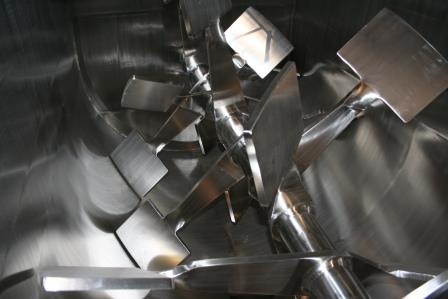Mixer-Dryer-Reactor System Speeds Production, Improves Quality
December 20, 2016

In addition to mixing systems, many companies use, dryer and/or reactor systems for their bulk powder processing applications. Dryer/reactors are ideal for mixing solids to solids, liquid to solids, or even solids to liquids in a wide variety of industries, including food and beverage, pharmaceutical, chemical, and plastics. Drying/reacting is typically achieved in a cylindrical vacuum/pressure capable vessel.
The drying process is a method of removing solvent(s) from a product with either reduced or elevated temperatures and pressures. Typical solvents extracted from product include water, alcohol, acetone, toluene, methanol, and ethanol, to name a few. To begin, the vessel is charged with the product (e.g. cake or slurry) and solvent. For processes that can exhibit an explosive atmosphere, an inert gas, such as nitrogen, could be inserted into the vessel to displace oxygen prior to charging the vessel. During the drying process the product is agitated by specially formed paddles along the heated or cooled wall of the vessel. Heat transfer is typically achieved through conduction (indirect transfer) with an ASME-certified jacket constructed on the outside of the vessel. The dryer is maintained under vacuum and at the maximum allowable temperature for the product until the final humidity level is reached.
The reacting process is a method for processing a product requiring a chemical reaction with elevated temperature and pressures. A reactant or reagent is introduced into the product (e.g. acid-based, polymer-based). Typical reactants added to product include nitrogen, hydrogen chloride, chlorine, oxygen, and others. Like the drying process, the product and reactant is charged into the vessel. Elevated internal pressures in the reactor with the addition of heating or cooling drives the reaction forward. The reaction can then be dried under vacuum to generate a finished product. After drying is completed the product is cooled down prior to discharging.
Table 1 identifies some typical dryer/reactor applications, the types of processes that can be performed, and the types of materials the vessels can be charged with.
The Challenge
Recently, a company was looking to mix an animal nutrition product consisting of corn and an organic solvent. The current system uses a double ribbon agitator to mix the corn and organic solvent (see Figure 1). After the product is mixed, it is transferred to a rotary dryer and dried to a moisture content of less than 2-3%. When the product is dried, it is transferred to a rotary cooler. Lastly, the cooled product is passed through screens to retain and separate the oversized product. Oversized product is sent through size reduction equipment to meet the desired specifications (see Diagram 1). The customer is looking for a new technology for the whole manufacturing process with upgraded equipment to reduce manufacturing cycle times and obtain better product quality, while meeting their capacity requirements. They would be interested in combining any or all the operations.
The Solution
A suitable alternative would be an all-in-one system that can perform mixing, drying, and cooling all in one vessel. A vacuum system can be added and the ribbon agitator replaced with a fluidizing mixing agitator to allow for faster mixing, drying, and cooling cycles. Diagram 2 illustrates an example of an all-in-one system.
Applying vacuum to the drying process lowers the boiling point of the solvent(s). For example, water boils at 212°F under standard atmospheric conditions. By lowering the atmospheric pressure to 25.5” HgV water will boil at 130°F. The lower boiling point allow the product to vaporize quicker due to the increased temperature differential between the product and the heated surface, thus increasing the heat transfer and the drying rate. Vapor is filtered through the pulse-back filter chamber to retain solids within the dryer. This makes vacuum drying suitable for products that are high cost and/or temperature sensitive.
Replacing the double ribbon agitator to a fluidized mixing agitator also provides a significant benefit. The fluidization individualizes the particles of the product to increase the available exposed surface of the product particle. This increased surface exposure improves the heat transfer and thus the drying cycle. Unlike the ribbon agitator, the fluidizing agitator provides an efficient and gentle mixing process including product with varying densities and particle size (see Figure 2).
The all-in-one thermal processing system can be outfitted with instrumentation and controls including: programmable logic controllers (PLCs), human machines interfaces (HMIs), sequential programming, variable frequency drives (VFDs), soft starters, trending, data logging, hazardous location, and intrinsically safe design.
So how do you justify moving to a different manufacturing process? Overall, the all-in-one system can be a can be excellent lower cost alternative. Besides combining three operations into one and reducing the total product cycle time, it can also be a nice alterative to outsourcing, eliminating the complexities associated with logistics, quality control, and the potential risk of losing intellectual property (processing technology). Several other quantitative and qualitative advantages include:
* Faster drying and cooling at lower temperature
* Faster reaction to completion
* Greater process control and flexibility
* Prevents degradation of temperature-sensitive products
* Eliminates the need for conveying equipment required to carry product vessel-to-vessel
* Avoids reduced equipment utilization
* Prevents microbial growth
* Creates dust-free product
* Lowers energy consumption
* Environment-friendly
Eirich Machines Inc. offers a comprehensive range of services to support bulk powders specialists in all phases of the product development cycle including: mechanical and electrical design; project management; laboratory trials; manufacturing/quality; installation and service/aftermarket.
John Whynott is product manager, Eirich Machines Inc., an ISO9000:2015 certified company. For more information, visit www.eirichusa.com.
For related articles, news, and equipment reviews, visit our Mixers & Blenders Equipment Zone
Click here for a List of Mixer & Blender Manufacturers
You May Also Like

